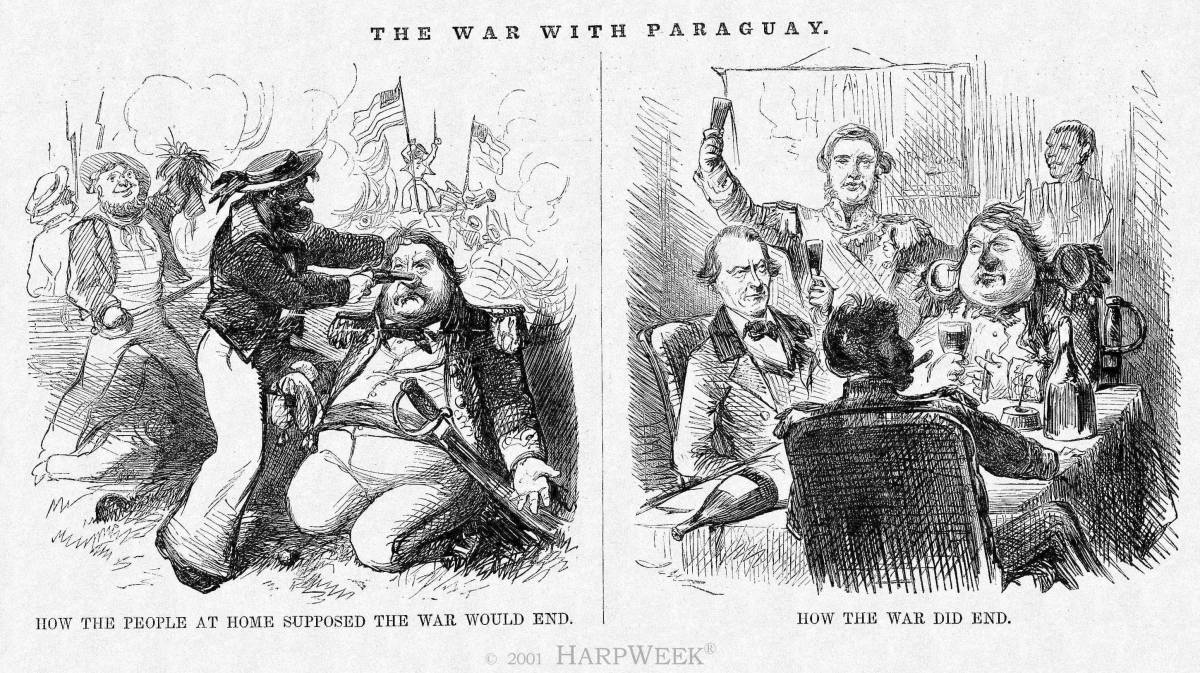

This Harper's Weekly cartoon (April 30, 1859) by John McLenan covers
an
episode in American military history which gained much press at the time,
but is
mainly forgotten today: the U.S. military expedition to Paraguay
in 1858-1859.
During the 1850s, Carlos Antonio Lopez, dictator of the small, landlocked,
South American country of Paraguay, was a thorn in the side of the United
States government. In 1853, Lopez refused to ratify a commercial
and
navigational treaty with the United States, and began confiscating the
property
of American citizens resident in Paraguay. Because of a dispute with
Britain,
Lopez closed Paraguayan waters to foreign warships. In February 1855,
Paraguayan soldiers fired upon an American ship engaged in a scientific
survey of the Parana River, killing one American crew member.
Nearly three years after the incident, and with a second scientific expedition
in
preparation, President James Buchanan decided that a show of force was
necessary to bring about a redress of the situation. In his first
annual message
to Congress of December 1857, Buchanan requested funding for a military
expedition to Paraguay. With a Congressional allocation of $10,000,
a naval
squadron of 19 vessels, 200 guns, and 2500 sailors and marines under the
command of Commodore William B. Shubrick embarked for Paraguay in the
early winter of 1858. It was the largest military expedition in the
peacetime
history of the United States to that date. Harper's Weekly
emphasized the
importance of the mission's demand that American citizens in Paraguay be
granted the same rights and protections that Paraguayan citizens in the
United
States were accorded.
After landing at Montevideo, Uruguay, the American force began the
1000-mile journey up the Parana River to the Paraguayan capital of
Asuncion. This was one of the major news stories in Harper's Weekly
during
the spring of 1859. The newspaper provided illustrations, portraits,
maps,
letters from participants, and reports from a special correspondent.
The
situation was dramatized by the news that the 2500 Americans were
preparing to face 15,000 of the best troops in South America. For
more
information, the journal directed its readers to a book on the region which
had
been published recently by the newspaper's parent company, Harper &
Brothers.
The April 2 issue of Harper's Weekly announced that a peaceful settlement
was probable, and the lead editorial of April 16 confirmed that the matter
had
been resolved amicably through the good offices of the Argentine president,
General Justo Jose de Urquiza. Lopez, the Paraguayan dictator, formally
apologized for the shooting incident of 1855, compensated the family and
employer of the slain sailor, and signed a treaty of commerce and navigation
with the United States. Cartoonist McLenan contrasts how the expedition
to
Paraguay was expected to end--with a military victory for the United
States--and how it actually did end--with a peaceful resolution and cordial
celebration.
Robert C. Kennedy